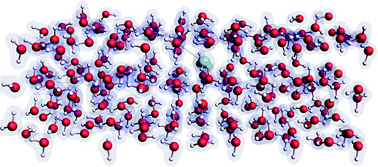Simulating core electron binding energies of halogenated species adsorbed on ice surfaces and in solution via relativistic quantum embedding calculations†
Abstract
In this work, we investigate the effects of the environment on the X-ray photoelectron spectra of hydrogen chloride and chloride ions adsorbed on ice surfaces, as well as of chloride ions in water droplets. In our approach, we combine a density functional theory (DFT) description of the ice surface with that of halogen species using the recently developed relativistic core–valence separation equation of motion coupled cluster (CVS-EOM-IP-CCSD) via the frozen density embedding formalism (FDE), to determine the K and L1,2,3 edges of chlorine. Our calculations, which incorporate temperature effects through snapshots from classical molecular dynamics simulations, are shown to reproduce experimental trends in the change of the core binding energies of Cl− upon moving from a liquid (water droplets) to an interfacial (ice quasi-liquid layer) environment. Our simulations yield water valence band binding energies in good agreement with experiment, which vary little between the droplets and the ice surface. For halide core binding energies there is an overall trend for overestimating experimental values, though good agreement between theory and experiment is found for Cl− in water droplets and on ice. For HCl on the other hand there are significant discrepancies between experimental and calculated core binding energies when we consider structural models that maintain the H–Cl bond more or less intact. An analysis of models that allow for pre-dissociated and dissociated structures suggests that experimentally observed chemical shifts in binding energies between Cl− and HCl would require that H+ (in the form of H3O+) and Cl− are separated by roughly 4–6 Å.



 Please wait while we load your content...
Please wait while we load your content...